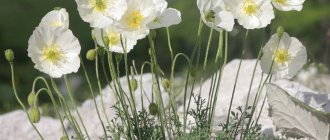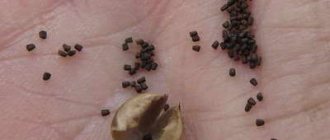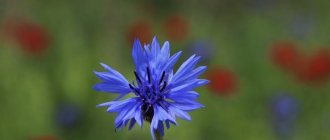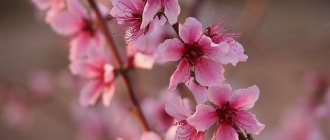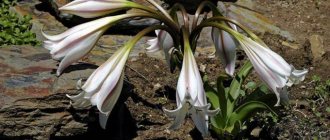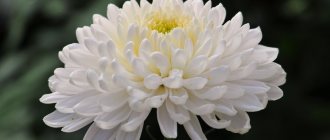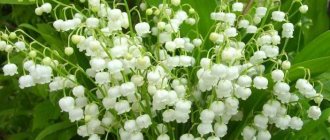Author: Natalya Category: Garden plants Published: October 04, 2017Republished: February 05, 2019Last edits: November 04, 2020
flower , or erigeron (lat. Erigeron) is a genus of herbaceous plants of the Asteraceae family, which according to various sources includes from 200 to 400 species, 180 of which are found in North America. Some of the small petal species are grown as ornamental plants. The name of the genus comes from two Greek words, which translated mean “early” and “old”: the quickly ripening seeds of Erigeron are decorated with a grayish tuft.
Planting and caring for erigeron
- Flowering: from mid-summer for 30-40 days.
- Planting: sowing seeds in the ground - before winter or early spring. Sowing seeds for seedlings - in March, planting seedlings in open ground - in June.
- Lighting: bright light or partial shade.
- Soil: light, drained, not oversaturated with fertilizers, alkaline.
- Watering: regular, sufficient.
- Feeding: complex mineral fertilizer during the budding period.
- Reproduction: seeds, cuttings, dividing the bush.
- Pests: not affected.
- Diseases: fungal rot.
Read more about growing erigeron below.
Diseases and pests
Diseases and pests do not pose a threat to Erigeron. However, for preventive purposes, it is recommended to treat the crop with wood ash, sprinkling it on the bushes of plants.
This is important: excess moisture in the soil can cause the development of fungal diseases.
Affected shoots must be destroyed. The fungus can be identified by spots of brown color.
Botanical description
Erigeron flowers are rhizomatous herbaceous annuals, biennials, perennials or subshrubs resembling perennial asters. Their stems are simple, erect or slightly lodging, few branches and rough. Basal whole or shallow-lobed leaves of an elongated oblong shape up to 20 cm long form a rosette, smaller stem leaves are up to 10 cm long. Baskets of 1-3 rows of marginal reed and median tubular flowers are located singly on the stems or form paniculate or corymbose inflorescences. Reed flowers can be pink, violet, purple, white, cream or lilac, and the middle ones are always yellow. Erigeron fruits have densely pubescent or bare achenes.
Description of small petal or erigeron
Due to the large number of needle-shaped, reed petals, the flower has a second name - small-petaled. "Erigeron" is translated from Greek as "early old man", which is due to the early ripening of seeds.
The bushes are formed loose, spherical. Numerous shoots are soft, grassy, and branch well. On average, the width and height of the bush is 40-60 cm. The greens have a rich dark green color.
Small petal flowering
The bush is evenly covered with baskets of flowers, single or collected in paniculate sparse inflorescences. The multiple petals come in pink, white, blue, yellow and other shades. Simple petals are arranged in one row, and terry petals are arranged in several.
The flower has a lush yellow core. Baskets can be of different sizes: 2 or 4 cm in diameter. The small petal blooms all summer and until October. Small, pubescent seeds ripen quickly. The entire stem is covered with oblong leaves, the basal rosette consists of more rounded leaves.
Planting small petals
The small-petalled plant is propagated by dividing the bush, cuttings and seed. Sowing of seeds is carried out before winter or early spring. Some types of erigeron are difficult to germinate, so they are grown in seedlings: in March, erigeron seeds are spread thinly and evenly over the surface of a moist substrate placed in a wide container, after which they are pressed to the surface and covered with glass or film. Keep the crops in a cool, bright place. The first shoots may appear only after a month, but as the seedlings mature, they grow faster and faster.
They pick up densely sprouted seedlings in the phase of forming two true leaves, and don’t be confused by the fact that the seedlings look miniature. If the seedlings grow spaciously, you can not pick the seedlings, but immediately plant them in open ground at the beginning of summer. Do not keep the seedlings warm: as soon as they get stronger, take them out onto the loggia or veranda.
- Sorrel: growing in the garden, properties
Small petals are light-loving, but can grow in light shade. They do not have any special requirements for soil composition, but they do not grow well in damp soils. The optimal location for erigeron will be a sunny area with alkaline soil that is not oversaturated with fertilizers.
Small petal seedlings are planted in June, removing the seedlings from the container along with a lump of earth. The distance between two plants is maintained within 25-30 cm. The small-petalled plant will bloom from seeds in the second year.
Possible problems
Erigeron is an easy crop to grow. Owners have virtually no problems with this plant.
A rare problem is the appearance of brown spots on stems and leaves. The reason is an excess of moisture in the soil.
In addition, the plant is quite problematic to propagate by seeds. Firstly, the seeds have low germination, and secondly, the seedlings are very fragile and thin, they are easy to damage.
Erigeron is an unpretentious and spectacular plant that will decorate the garden plot with its bright flowers. Culture is successfully used in landscape design. The plant is easy to grow and maintain with minimal care.
Caring for small petals
As you can see, planting erigeron is a simple procedure, and caring for the plant consists of regular moderate watering, after which the soil is loosened between the rows and weeds are removed. Erigeron does not need fertilizing, but if it is fed with complex mineral fertilizer during budding, the flowering of the small petal will be brighter and longer.
At the end of the growing season, the stems of the plant are cut off, and perennial small-petalled species in areas with cold winters are covered with leaves or dry grass.
In rainy summers, erigeron in open ground can be affected by fungal infections, and then dark brown spots appear on its leaves. As soon as you detect these signs, treat the plants 3-4 times with a one percent Bordeaux mixture at intervals of 10 days or sprinkle the bushes with ash. In case of severe damage, cut off the above-ground part of the bush and burn it, and spray the soil with a fungicide.
After 3-4 years, the perennial small petals are rejuvenated: the bushes are dug up, divided and planted. The plant tolerates this procedure easily.
- Tulip bulbs
Popular new varieties of small-petalled perennial
Lychnis perennial - planting and care in open ground
This flower is a real decoration for a flower bed. It is suitable for hanging, so it is used to decorate the facades of houses. A large number of varieties allows you to choose the appropriate flower color, height and bushiness.
Erigeron Pink Treasure: growing from seeds
Erigeron Pink Treasure is very similar to the aster in shape and is quite easy to grow from seed. The color of the flowers can be different shades of pink with a constant yellow center.
Erigeron Foster Laibling
Erigeron Foster Libling has fairly wide, rough leaves with towering powerful stems, densely covered with large flowers of intense pink color. Their diameter can reach 5 centimeters, and the number of petals form semi-double inflorescences.
Small petal daisy leaf
The peculiarity of this variety is that during flowering the color changes from pink to white and then back to a rich crimson color. The small-petalled daisy-leaf blooms profusely, forming a thick cover of flowers in the flowerbed.
Small Petals Azur Beauty
The small petal variety erigeron Azur Beauty has a beautiful pinkish-bluish color of flowers that are shaped like asters. Flowering is quite long - throughout the summer. The resulting seeds, falling into the soil the next year, provide new shoots of the plant.
Small Petal Rose of July
The peculiarity of this variety is that their flowers have elongated marginal petals. The size of the inflorescence of the small-petalled Rose of July is quite large, which increases the decorative value of the plant.
Types and varieties
Several types of erigeron are grown in culture, as well as its numerous varieties and hybrids.
Beautiful small petal (Erigeron speciosus = Stenactis speciosa)
The most common cultivated species that grows in the wild in western North America. It is a perennial with a short horizontal rhizome and branched, leafy, erect, rough stems up to 70 cm high. The basal leaves of the plant are spatulate, and the stem leaves are lanceolate. Baskets consisting of lilac reed and yellow tubular flowers are collected in large corymbs. Flowering begins in July or August and lasts up to 30 days. The species has been in culture since 1826. Among the most popular varieties of the species are the following:
- Violetta - this double variety has dark purple reed flowers;
- Wuppertal - a bush up to 45 cm high with baskets up to 5-6 cm in diameter with three rows of lilac flowers;
- Dunkelsnee Adler - a variety with reed flowers of an ultramarine hue;
- Lilofee - semi-double variety with dark purple flowers;
- Sommerneuschnee - bushes up to 60 cm high with baskets up to 4 cm in diameter with white reed flowers, which turn pink towards the end of flowering;
- Rose Triumph is a double variety with reed flowers of a dark shade of pink;
- Festers Libling - double variety with pink reed flowers;
- Rote Shengayt - semi-double baskets with reed flowers of a pink-red hue;
- Prosperity is a variety with light blue reed flowers.
Karvinskian small petal (Erigeron karvinskianus = Erigeron mucronatus)
A low-growing plant from Central America, which appeared in cultivation quite recently and is not yet very widespread. In its homeland, this species grows like a weed. Erigeron Karvinsky forms a compact bush up to 15 cm high, which can be easily placed in a container, basket or other hanging structure. When grown in the ground, the bush can grow up to 60 cm in diameter. At the ends of the branched thin stems, baskets resembling small pink daisies appear throughout the summer, which gradually turn white, and then again acquire an intense red-pink hue.
Erigeron aurantiacus
Originates from Central Asia and northwestern China. This plant is 30-40 cm high and up to 50 cm in diameter. Its stems are straight, the leaves are oblong-oval, single inflorescences with yellow tubular and orange reed flowers reach a diameter of 3 cm. The species has been in cultivation since 1879.
Erigeron alpine (Erigeron alpinus = Erigeron schleicheri)
It grows wildly in Asia Minor, Western and Central Europe, reaching a height of 30 cm. It is a perennial small-petalled plant with straight, rough stems, linear-lanceolate basal leaves and rare elongated sessile stem leaves. Single baskets with a diameter of 3-3.5 cm consist of yellow tubular and lilac-pinkish reed flowers. Flowering lasts a month and a half from mid-June. The plant has been in cultivation since 1759.
Small petal (Erigeron acris)
Or small-petaled acute - a changeable biennial species, within which there are many forms. The height of the plants reaches from 6 to 75 cm, they usually have one erect, pubescent and branched green or purple stem at the top, green, sparsely pubescent leaves and baskets collected in panicles with pink reed and yellow tubular flowers.
Annual small petal (Erigeron annuus)
Or the annual slenderweed , an invasive species brought to Europe from North America. The plant reaches a height of 30 to 150 cm. It has a straight, branching stem at the top with sparse bristles, bristly-hairy green leaves and numerous baskets collected in panicles or scutes up to 10-15 cm in diameter. The baskets consist of two rows of pale blue or white pseudolingulate and yellow tubular flowers. This species has no decorative value, and currently grows in gardens exclusively as a weed.
- Crocus flowers
Canadian small petal (Erigeron canadensis)
Also an annual plant, not attractive, but used in folk medicine to stop uterine bleeding. Its baskets are small, with white reed and pale yellow tubular flowers.
In addition to those described, in culture you can find such types of erigeron as single-flowered, naked, pendulous, northern, elongated and woolly-cupped, but not all of them are decorative.
Varieties
Karvinsky
The most popular plant species that are often grown in Russian gardens include the following:
- Karvinsky is the most common variety. The height of the bushes of the plant does not exceed 15 cm. But the bushes grow in width to half a meter or more. The flowers of this species are also amazing. After the flower opens, the petals have a pale pink tint. Then they become almost white in color. And at the very end of ripening they turn pink or even crimson again. Since all the baskets do not open at the same time, the bushes are covered with numerous colorful flowers;
- Pink Diamond is another equally popular variety for garden growing. The bushes are of medium size. The lateral stems are creeping, so to give the bushes the correct shape they need to be tied up. The flowers are bright and double. The color of the petal is rich pink with a purple tint;
- Treasures of Agra is a spectacular, frost-resistant variety. The height of the bush reaches half a meter or more. The inflorescences are small. The core of the flower is yellow. The color of the petals is varied;
- Pink treasure is a tall (up to 70 cm) variety of Erigeron. Double flowers. The color of the marginal petals is pink or crimson. Flowering occurs in June-July and repeats in early autumn.
How to plant erigeron
We plant it in a permanent location after the last frost. We place the bushes at a distance of at least 25 cm from each other. Erigeron grows in the first year, but will bloom only in the second summer.
This plant is undemanding in terms of soil and light, so erigeron can be planted in partial shade or on poor soils. Unless you can plant erigeron in damp, completely shaded corners of the garden, otherwise erigeron will not bloom, and it will hurt from stagnation of water in the roots.
Small petals in landscape design
In open ground, gardeners prefer to plant perennial erigeron in company with zinnias, yarrow, ursinia and others. The flower looks good with sage and lobelias.
They can be placed on the site in various places: along paths, in rock gardens, hanging flower pots.
Low-growing varieties are preferably placed in the foreground
Perennial erigeron is placed as a background in flower beds if the variety is tall. It is recommended to use heuchera, daisies and gaillardia as companions.
When choosing a site, you should take into account that the plant grows, so in the garden you can create multi-colored “carpets” of small-petalled perennial
Methods of application
In folk medicine, flowers, leaves and young stems of the annual small petal are used. They are used in a variety of variations, in the form of an infusion or decoction, and also as a lotion or poultice.
Infusion
An infusion of small-petaled annual is used to relieve pain. It is prepared as follows:
- Take 20 g of dried erigeron herb and pour it into a liter glass jar.
- Fill it with 1 liter of hot water.
- Leave for 10-15 minutes.
Decoction
For decoction, dried stems of annual small petal are often used. The preparation scheme is similar to obtaining an infusion:
- 1 tsp. dried erigeron herb with a slide is poured into a half-liter jar.
- Fill it with ¼ liter of boiling water.
- Let the broth brew until it cools completely.
Tea
In addition to the small-petalled annual plant, other plants are also used to prepare medicinal tea. For example, for a drink that helps alleviate cystitis and urethritis, you should prepare a mixture of equal amounts of erigeron, hibiscus, goldenrod and birch leaves. After 1 tbsp. l. Brew the resulting mixture in 1 liter of boiling water. It is recommended to drink no more than 3 glasses of this tea per day.
You can also prepare a medicinal drink to cleanse the body and remove toxins. In this case, annual small petal, meadowsweet and goldenrod are mixed in equal quantities. 1 tsp. The resulting mixture is brewed in 250 ml of boiling water. You can drink 2 glasses of tea a day.
Oil
Small petal oil is used as a hemostatic agent mainly for uterine bleeding. To do this, take 5-10 drops orally, repeat the procedure if necessary.
Tincture
An alcohol tincture of small petal annua is an excellent remedy for the treatment of arthritis. Before use, it must be diluted with water.
Features of cultivation and reproduction
Erigeron can be propagated by dividing the bush, as well as by seed. Erigeron seeds are planted in November or early spring. Growing from seeds at home involves the formation of seedlings and their further planting in the garden. This option is more recommended for the northern regions. Seeds do not have the highest speed, so it is better to use them in excess.
We invite you to familiarize yourself with Raspberry Orange Miracle [variety description, care features]
Placement in pots and boxes is carried out in early March. Shoots do not appear for a long time, and this is precisely the reason for this decision. After the young shoots appear, they are also in no hurry to grow. The seeds must be evenly distributed on the surface of such soil, which should be moistened in advance.
https://www.youtube.com/watch?v=udY0mc7Mv_0
Growing low-growing annual dahlias with decorative coloring
Crops need a moist environment. The optimal temperature varies from 10 to 15 degrees Celsius. You can place the flower on a glazed balcony or a regular window sill. After a month, the first shoots will be visible. They are quite thin and small, but over time they take root and grow faster. It is necessary to ensure that the substrate does not dry out. To do this, use small portions of warm water, which are used to water the soil.
It is best to propagate erigeron by dividing the bush. For this purpose, they dig up a large, lush bush 3 years old. They do this in early spring. Divide the roots into several sprouts. Shoots with small roots take root well. You can rejuvenate flowers and combat excessive vegetation. Such events should be done once every 5 years.
Regardless of the propagation method, maintain a minimum distance of 35 cm between young specimens. Thanks to this, the soil does not suffer from a lack of minerals, and the roots develop normally.
Collection and preparation
Collection of annual small petals for medicinal purposes can be carried out throughout the entire growing season (from June to September). But the most favorable time for harvesting raw materials is still considered to be the period when flowering begins. It falls around the end of June and beginning of July.
If the bush of the plant is tall enough, then only the tops of the shoots should be cut off, without affecting the rough part of the stems.
After collection, the cut shoots are distributed into bundles of the same size and tied with thread. Hang the collected plants to dry in a place protected from direct sunlight, preferably under a canopy. This is necessary to maximize the preservation of all the beneficial qualities of erigeron.
Since the herbaceous part and small petal flowers are often used separately for medicinal purposes, after complete drying it is recommended to separate the buds from the stems and place them in different containers.
The shelf life of dried raw materials in a cardboard box is no more than 1 year. Afterwards the plant begins to lose its medicinal qualities.
Medicinal properties of small petal annual
The annual small petal itself, despite the fact that from the photo it looks like a rather simple and unremarkable plant, is considered in folk medicine to be an excellent assistant in the treatment of many diseases.
The main feature of annual small petal is that it is not addictive with long-term use
The composition, rich in microelements, makes it possible to use this plant as a natural anti-inflammatory agent. And the content of tannin and flavonoids in it promotes the removal of uric acid, which is an undeniable advantage in the treatment of gout.
It is also worth noting that the plant has a hemostatic effect, so it is recommended to take it for hemorrhoidal and uterine bleeding. And poultices can reduce or completely prevent pain.
The tannins contained in the annual small petal make it a good remedy for diarrhea.
The antiseptic and analgesic properties of erigeron help with sore throat. The use of the plant against hair loss has also been noted.
